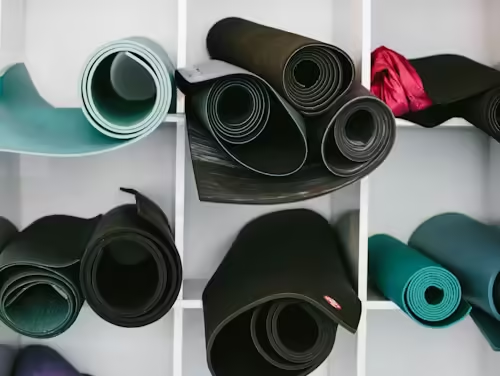Introduction
Choosing the right yoga mat is like finding the perfect pair of shoes—it needs to feel right and support your needs. Whether you’re focused on comfort, grip, or sustainability, the right yoga mat can make all the difference in your practice. Let’s explore the various options so you can find the perfect mat tailored to your yoga journey.
Table of Contents
Why choosing a right Yoga Mat is Important ?
While you may not think of a mat as being important when it comes to the establishment of this new habit “YOGA” in your life, having the right kind can actually make great difference. The best yoga mat for beginners should be comfortable enough without making you feel like you are slipping.
Thinking of doing a pose on a slippery or uncomfortable surface ! as if you are sucked out, totally throws off your balance and now the practice just become less fun. The right yoga mat will enhance your experience as you try new poses and advance in your practice, and it can help keep that passion alive.

Know the basic feature of a Yoga Mat
While searching the best yoga mat for beginners, we must need to know different factors which can effect on your practice work. Let’s break it down:
Material
Natural rubber, cork, PVC and TPE are all common materials used in making yoga mats. PVC Mats — Typically cheaper and more durable, as opposed to other materials may not be the best for our environment Rubber and cork mats are made of natural materials so they are eco-friendly, and oftentimes can provide better traction in comparison with cheaper PVC mats. At any level, you should be searching for a mat with sufficient cushioning and traction but for beginners especially this will often involve a trade-off between material quality and price.
Texture
Another important factor in preventing slipping on a yoga mat is its texture. There will be greater grip on a mat with some texture (not too smooth like PVC mats), which can be quite beneficial when you start to perspire while practicing.
If you like a smoother feel, use a mat with a non-slip layer to make sure you don’t slip. Weight and portability: If you plan to take your mat to outdoor yoga classes or sessions, weight becomes an important consideration.
Thickness
The thickness of your yoga mat also determines how comfortable you are and well-balanced. If the mat is too thin, you might feel your floor under you enough for poses that are uncomfortable as well. The problem though is, If it’s too thick it will decrease your stability. An ideal mat for a beginner will be 5-8 mm thick — this means it has enough padding to cushion your joints and stability for standing poses.
Type of Yoga Mat to Consider ?
Now, as you have understood what to look for, in a yoga mat, let’s go through some popular varieties of Yoga mats each of which has its own unique purpose:
Standard Yoga Mat
A standard yoga mat is a reliable and versatile choice for most beginners, offering a balance of comfort and stability. It’s ideal for general yoga practices, including Hatha, Vinyasa, and even gentle restorative yoga. These mats provide just enough cushioning to protect your joints while maintaining a firm surface for balancing poses. A standard mat is a great entry point for beginners who want a functional, all-purpose mat without diving into specialized options.
- Dimensions:
- Length: 68-72 inches (173-183 cm)
- Width: 24 inches (61 cm)
- Thickness: 1/8 inch (3.2 mm)
- Weight: 2-4 pounds
- Best for: General yoga practice, suitable for both beginners and intermediate practitioners.
- Pros: Lightweight and easy to carry, suitable for various yoga styles.
- Cons: May not offer enough cushioning for people with sensitive joints.
Non-Slip Yoga Mat
A non-slip yoga mat is perfect for those who practice more dynamic forms of yoga like Hot Yoga, Ashtanga, or Power Yoga. The surface of this mat is designed to increase grip as moisture builds up, preventing you from sliding even during intense and sweaty sessions. With enhanced grip and a textured surface, non-slip mats help maintain stability in challenging poses and ensure safety during your practice.
- Dimensions:
- Length: 68-72 inches (173-183 cm)
- Width: 24 inches (61 cm)
- Thickness: 1/8 to 1/4 inch (3.2 to 6 mm)
- Weight: 3-5 pounds
- Best for: Hot yoga, power yoga, or any practice where sweat is common.
- Pros: Excellent traction, even when wet.
- Cons: Heavier and more difficult to clean.
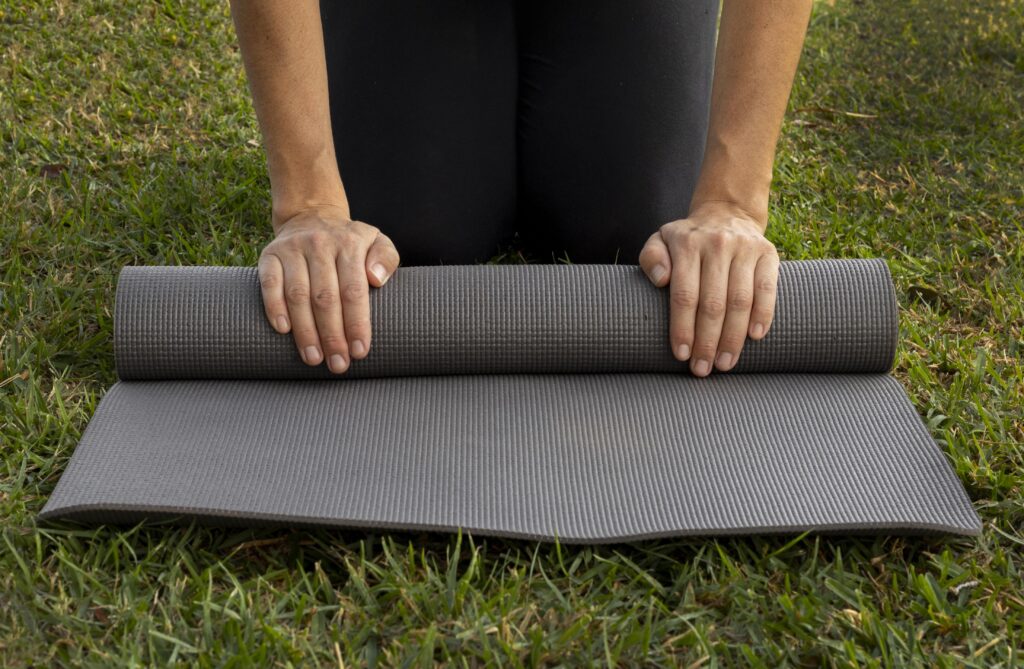
Eco-Friendly Yoga Mat
With the advent of knowledge and technology people are now more vigilant than ever. Youth inspired by activist like Greta Thunberg are increasingly concerned about their carbon footprint, for eco-conscious practitioners, eco-friendly yoga mats are a perfect choice, made from sustainable materials like natural rubber, jute, and cork, these mats help reduce your carbon footprint without sacrificing performance. They provide a good balance of comfort, grip, and durability, while also being biodegradable and free from harmful chemicals. This makes them a fantastic choice for yogis who want to practice in harmony with the environment.
- Dimensions:
- Length: 68-72 inches (173-183 cm)
- Width: 24 inches (61 cm)
- Thickness: 1/8 to 1/4 inch (3.2 to 6 mm)
- Weight: 4-6 pounds
- Best for: Yogis who prioritize sustainability and prefer natural materials.
- Pros: Biodegradable, durable, made from non-toxic materials.
- Cons: Heavier and can have an initial rubber odor.
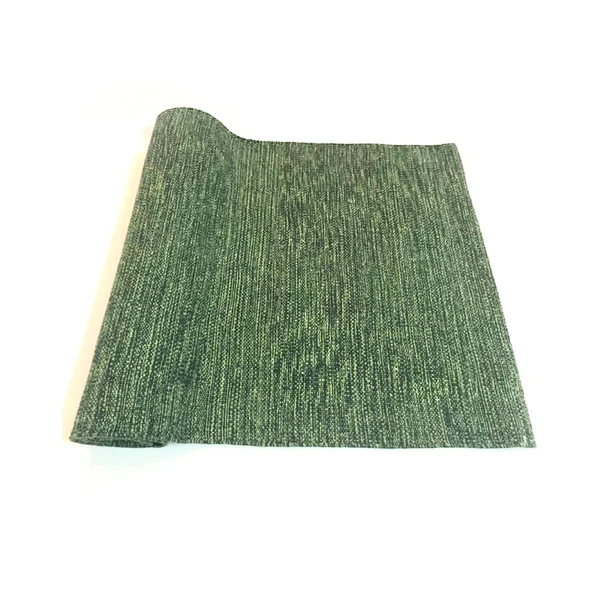
Extra-Thick Yoga Mat
If comfort is your top priority, an extra thick yoga mat might be your best choice. These mats are designed to provide superior cushioning, typically around 1/4 inch (6 mm) or more in thickness. They are ideal for practitioners with sensitive joints, those recovering from injuries, or anyone who enjoys a softer surface during meditation and seated poses. While thicker mats offer more cushioning, they may reduce stability for standing and balancing postures.
- Dimensions:
- Length: 68-72 inches (173-183 cm)
- Width: 24 inches (61 cm)
- Thickness: 1/4 inch (6 mm) or more
- Weight: 4-7 pounds
- Best for: People with joint issues, those looking for extra cushioning, or those practicing restorative yoga.
- Pros: Exceptional comfort and cushioning for joints.
- Cons: Can make balancing poses more difficult.
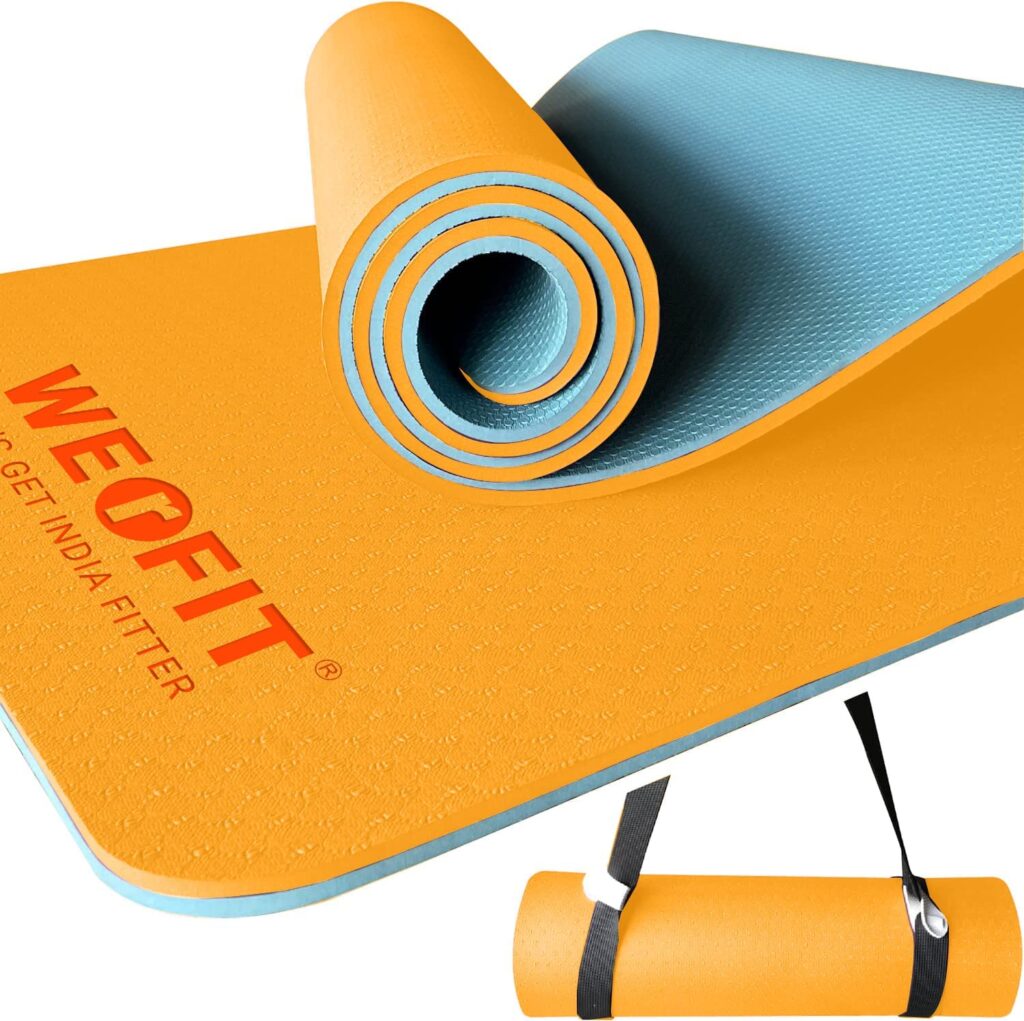
Travel Yoga Mat
For yogis on the move, a travel yoga mat is a must-have. These mats are designed to be ultra-lightweight and foldable, making them easy to pack in a suitcase or carry-on bag. While they are thinner and provide less cushioning than standard mats, they are perfect for those who prioritize portability over comfort. A travel yoga mat ensures you can maintain your practice no matter where you are, whether it’s a hotel room, beach, or airport lounge.
- Dimensions:
- Length: 68 inches (173 cm)
- Width: 24 inches (61 cm)
- Thickness: 1/16 to 1/8 inch (1.5 to 3 mm)
- Weight: 1-2 pounds
- Best for: Travelers or anyone who needs a lightweight, portable mat.
- Pros: Extremely portable and easy to carry.
- Cons: Minimal cushioning, may not be suitable for longer or more intense practices
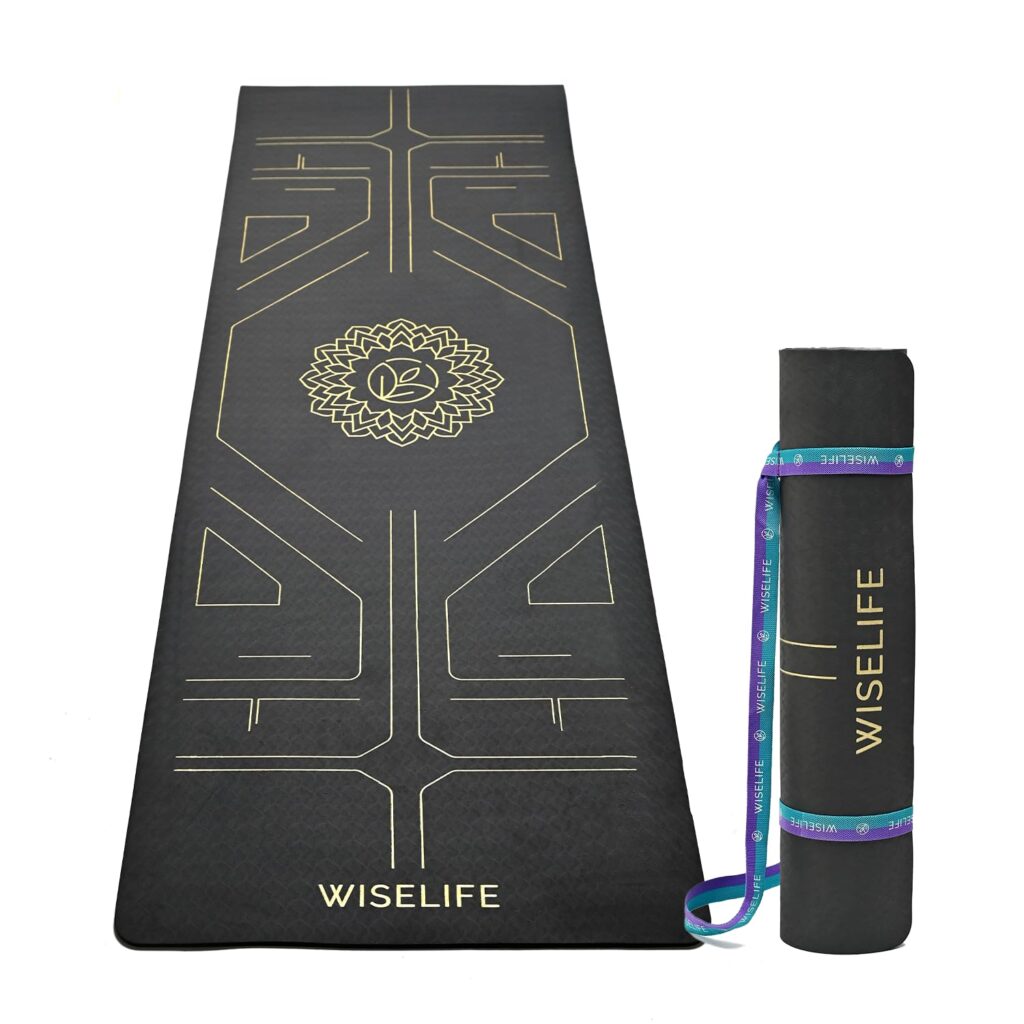
Where to invest ! Quality or Budget ?
Purchasing the cheapest yoga mat could seem a better option to beginners, but it might not be a durable choice. Here is what to ensure before moving further:
Options for a tight budget: The best yoga mat doesn’t have to be expensive. Numerous options at reasonable prices are present which are durable. But, they might not feel as plush or endure as long as more expensive carpets.
Premium mats: While a premium yoga mat may initially cost more, it typically offers greater durability, support, and grip. Investing on a premium mat can help you save money if you take your practice seriously.
The secret is to keep quality and pricing in check. Although the most expensive mat on the market is not necessary, it might help you practice more effectively and enjoy your yoga sessions even more.
Maintenance & Durability
The best yoga mat isn’t just about how it feels during practice – it’s also about how easy it is to maintain. Regular cleaning and proper storage are essential to extend the life of your mat.
Cleaning: Most yoga mats can be cleaned with a simple solution of water and mild detergent. For mats made of rubber or cork, it’s important to avoid harsh chemicals that can damage the material. Make it a habit to wipe down the mat after every practice to keep it fresh and clean.
Storage: Always store your mat in a dry, cool place, out of direct sunlight. Keeping it wrapped up on the practice side helps prevent the edges from curling. Taking these small steps will help maintain the mat’s grip
Durability: Keep an eye out for signs of wear. Over time, even the best yoga mat can lose its grip or cushioning. When this happens, it’s time to buy a new mat to ensure a safe and effective practice.
Popular Brands to Consider for Beginners
When looking for the best yoga mats, it’s helpful to know which brands are trusted in the yoga community. Here are some well-known names:
Manduka: Known for durable, high-quality mats that are ideal for serious yogis. Their beginner-friendly options balance quality with ease of use.
Liforme: Well-known for its alignment-focused designs and eco-friendly mats, Liforme is a popular choice for those looking for a premium option.
Gaiaam: Offers a variety of affordable mats for beginners. They offer good quality at a more budget-friendly price.
Choosing a trusted brand gives you confidence in your choice, knowing you’re getting a product that’s been tested and loved by other yoga practitioners.
Summary
Selecting the perfect yoga mat is a personal journey. Your mat should align with your practice style, comfort needs, and values, whether that means prioritizing eco-friendliness, grip, or portability. By considering the different types of yoga mats available—standard, non-slip, eco-friendly, extra thick, and travel—you’ll be better equipped to find the ideal mat to enhance your yoga practice. Remember, yoga is a personal journey, and so is your mat choice.
Just keep in mind the 5 points – Material, Texture, Thickness, Weight and Usage style
Take the time to explore the different options and choose the right one for you, so that your practice is both enjoyable and effective.
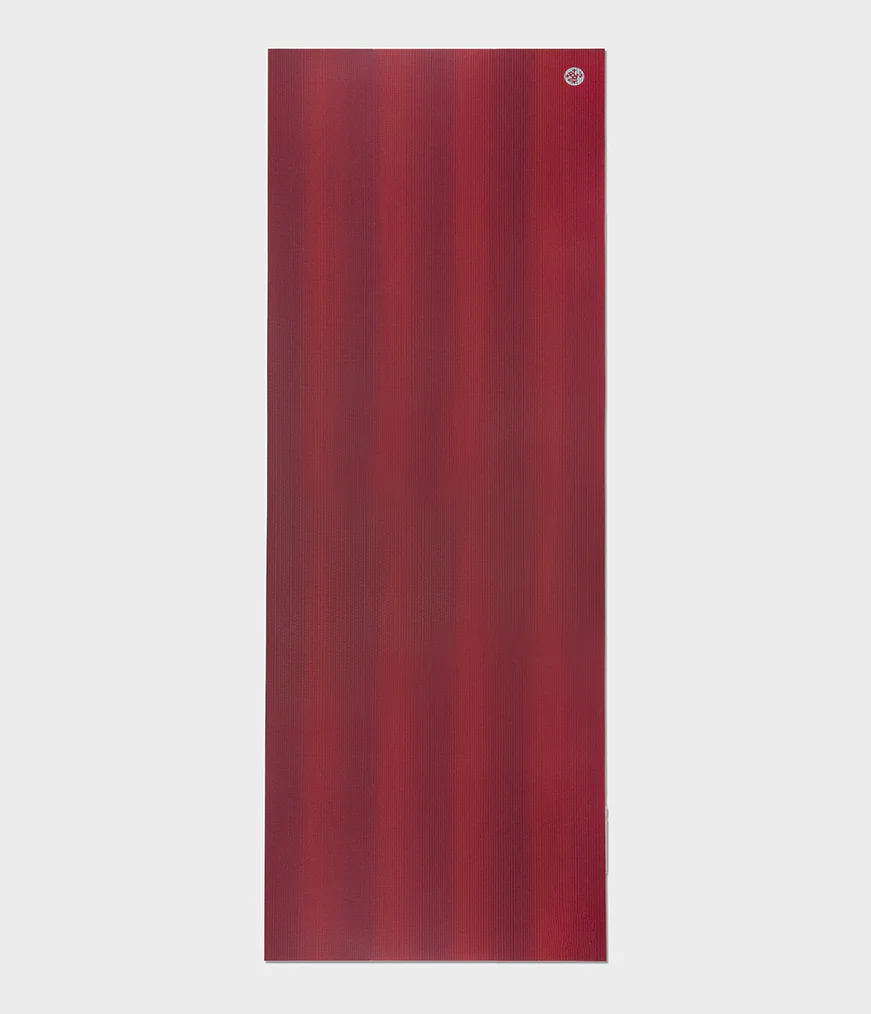
FAQs
What is the best yoga mat for beginners?
Beginners should look for a mat with 4-6mm thickness for balanced cushioning and stability. A good grip is essential to prevent slipping, and durability ensures long-term use. Brands like Manduka and Liforme offer excellent beginner-friendly options.
Which is the best yoga mat for joint support?
An extra-thick mat, 6mm or more, is ideal for joint support, offering superior cushioning. Manduka PRO and Liforme mats are popular choices in this category, providing both comfort and durability for users with sensitive knees or wrists.
What material is the best for a yoga mat?
Natural rubber, cork, and TPE are the best materials for yoga mats due to their non-toxic, eco-friendly nature, and excellent grip. These materials also offer durability, making them suitable for both regular and intense practices.
Which brand offers the best yoga mats for daily practice?
For daily use, brands like Manduka, Liforme, and JadeYoga stands out. They provide high-quality mats known for their durability, non-slip surfaces, and comfort, making them great for consistent practice over time. You may also go for other brands as per stock availability and your budget.
How do I choose the best yoga mat for my practice style?
For vigorous styles like Vinyasa or Ashtanga, opt for a non-slip mat with a medium thickness. For gentler practices like Yin or restorative yoga, a thicker, cushioned mat provides more comfort and support.

